Energy is the most important indicator of the development of each country. Lack of natural natural resources increasingly compels scientists around the world to develop new alternative energy sources. However, due to the prevailing circumstances at the current stage, it is doubtful that in the next decade any replacement will be found. existing species fuel. Oil, gas, coal and nuclear energy will hold the title of the main types of energy production for a long time to come.
Russia is rightfully considered one of the leaders in the development, production and supply of gas to the world market. Nature has generously endowed her with this type of raw material. About two hundred gas and gas condensate fields have been developed and developed. The main peak of field discoveries came in the late sixties - early eighties of the last century. 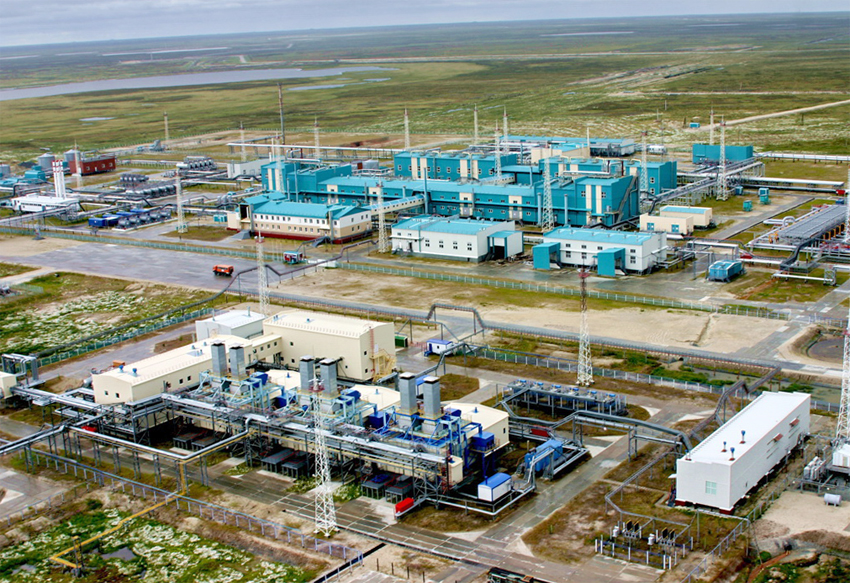
The main deposits were discovered in the Arctic, North-West Siberia and the Far East. Some gas fields in the Russian Federation are not only the largest in the world, but also unique.
Urengoyskoe
The Urengoyskoye field belongs to the category of supergiant. By the amount of gas reserves, it firmly ranks third on the planet. Sixteen trillion cubic meters- approximately this is how the volume of gas that it is capable of producing is estimated. The deposit was first discovered in the Yamalo-Nenets Autonomous Okrug in 1966, near the village of Urengoy. Already in the seventy-eighth, capital production began, and since 1984, Urengoy gas began to be supplied to western countries.

To date, slightly less than 70 percent of all underground reserves have been developed. But developments are not losing their intensity. So, last year, new powerful pumping stations were built and put into operation, which allow increasing the production and transportation of gas from this region. Since 2009, the development of the Achimov layers of the Urengoyskoye field has been underway, which makes it possible to obtain more than 90 percent of gas condensate.
Yamburgskoe
Yamburgskoye has reserves of about 8.2 trillion cubic meters of gas and belongs to the world's largest deposits. The opening falls on 1969 on the Tazovsky Peninsula in the Yamalo-Nenets Autonomous District. In the eightieth year, the gas from this field began to be produced on an industrial scale.
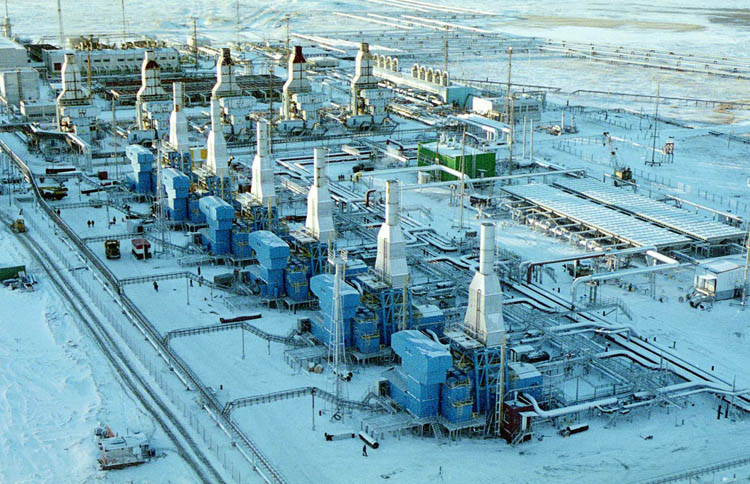
According to the latest data, about forty-six percent of the total gas volume has been developed. The peculiarities of the Yambur field include gas production in permafrost conditions, the thickness of the frozen ground reaches 40-50 meters. Drilling is carried out to a depth of 1 to 3 km.
Bovanenkovskoe
The Bovanenkovskoye field is also not inferior to many world reserves in terms of gas reserves. 4.9 trillion cubic meters- such a figure, according to experts, characterizes its volume. 1971 saw the discovery of these gas reserves on the Yamal Peninsula. For one reason or another, gas production from this field has been constantly postponed since 2001. After the start of continuous production in 2012, it began to actively supply gas for export.
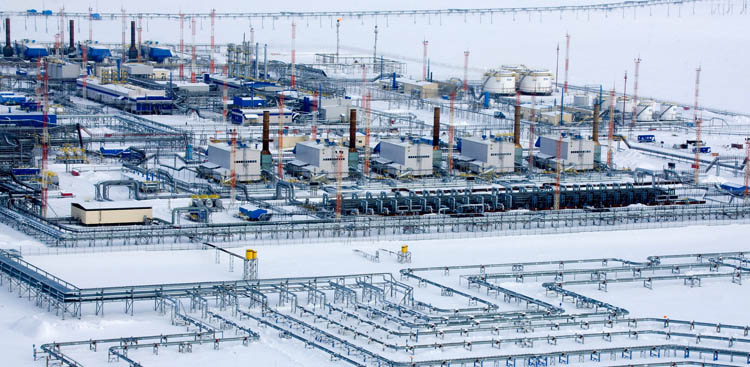
The main recipient of raw materials is China. In 2014, the second gas field was commissioned. This makes it possible to increase production to 90 billion cubic meters of gas per year. The Bovanenkovskoye field can be safely called promising.
Shtokman
The Shtokman field is rightfully one of the richest in terms of gas and gas condensate reserves. The volumes of gas and condensate located there are calculated in figures in 3.94 trillion cubic meters and 56 million tons, respectively. It was first discovered in 1981.
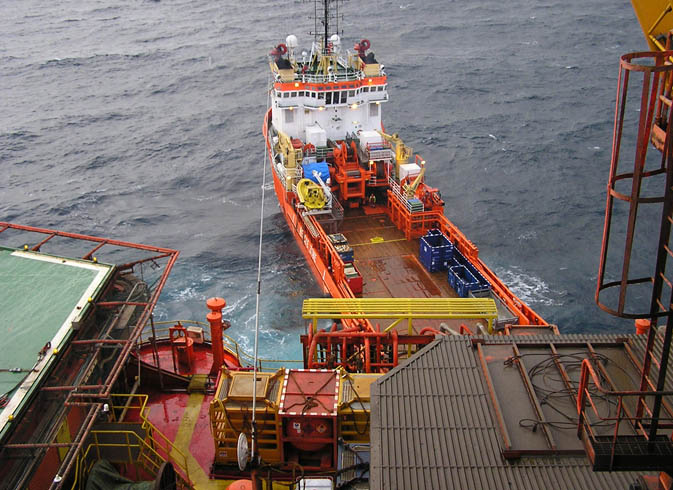
The first trial production was carried out in 1988. Located in the Barents Sea, between Murmansk and Novaya Zemlya. Sea depths from 300 to 400 meters. The dates for launching the field at full capacity are constantly being postponed. Latest figures point to 2019.
Leningradskoe
Leningradskoe gas condensate field, like many others, it was opened in the ninety-second year of the last century. According to the estimated reserves, it immediately received the title - gigantic. According to the latest data, the amount of gas in there may be about 3 trillion cubic meters... Condensate deposits are estimated at about 3 million tons. The location is in the southwestern part Kara Sea.
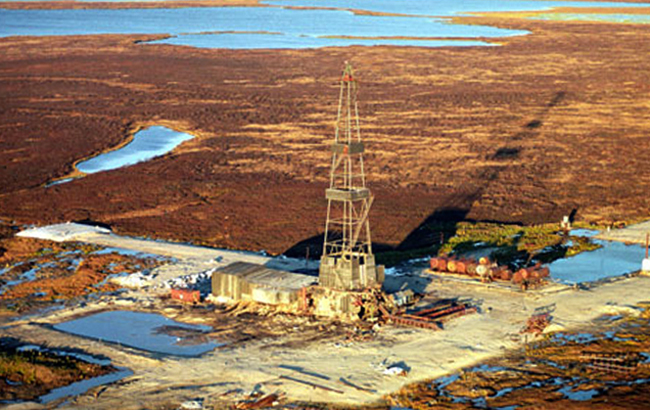
Rusanovskoe
The Rusanovskoye gas field is one of the unique ones. The opening falls on 1992. Located on the continental shelf of the Northwest Platform. Kara Sea. Stocks are estimated 779 billion tons of gas however, there is an assumption that this figure could reach three trillion cubic meters and 7.8 million tons of gas condensate. The main developed reserves are located at depths from one and a half to two and a half kilometers.
Zapolyarnoye
The Zapolyarnoye gas condensate field was discovered in 1965 between Urengoy and the village of Tazovsky. In terms of gas reserves, it belongs not only to the largest deposits in Russia, but also ranks fifth in the world. Initial stocks were determined in 2.6 trillion cubic meters... Commissioning took place in 2001.
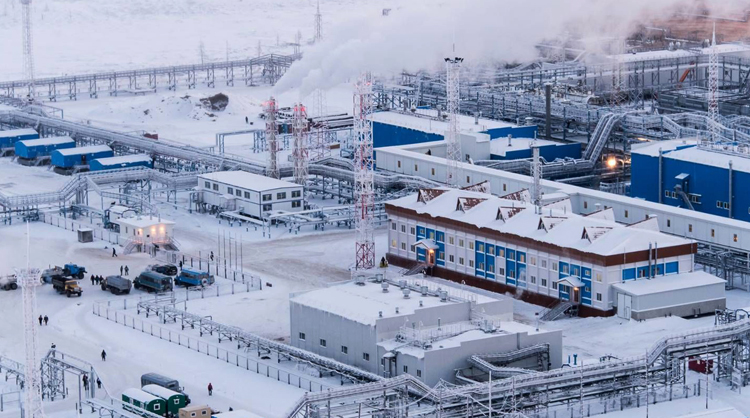
Bearish
Bear gas field is not only one of the largest, but also unique. Opened in 1967. It has been in constant operation since 1972. Located in the Yamalo-Nenets District. Initial gas reserves were estimated at 4.7 trillion cubic meters... To date, almost half of it has been worked out.
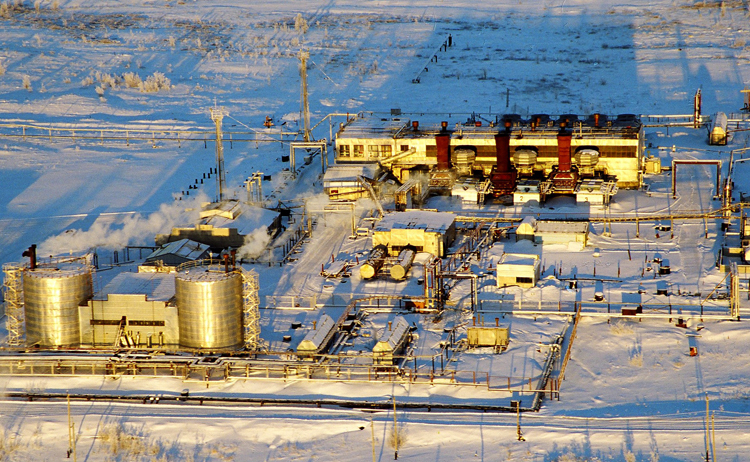
In terms of the amount of gas produced, this field accounts for about four percent of all gas production in Russia. Despite the significant development due to natural features may get a "second wind" by 2030. This is evidenced by the work on the modernization of equipment and improvement of gas production, which will be completed in 2017.
Astrakhan
The Astrakhan gas field dates back to 1976. It was discovered near Astrakhan and became part of the Caspian region of oil and gas development. Estimated reserves: 2.5 trillion cubic meters of gas and 400 million tons of condensate... Full-scale operation began in 1987. In 2014, another large gas field was found near Astrakhan. The discovery, made for the first time in 20 years, suggests that the area is still rich in surprises.
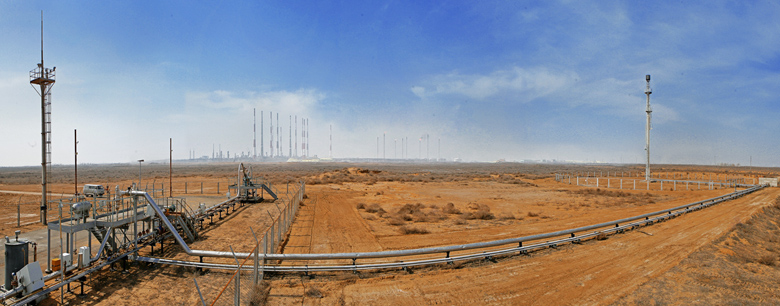
Sakhalin-3 is a promising project for the development and development of several large gas fields, opened and opened from the end of the seventies of the last century in Pacific, east of Sakhalin Island. The main ones are the Kirinskoye, Yuzhno-Kirinskoye and Mynginskoye gas fields. It is planned to produce gas at the level of 1.1 billion cubic meters of gas. The initial reserves of the field are 162.5 billion cubic meters. gas.
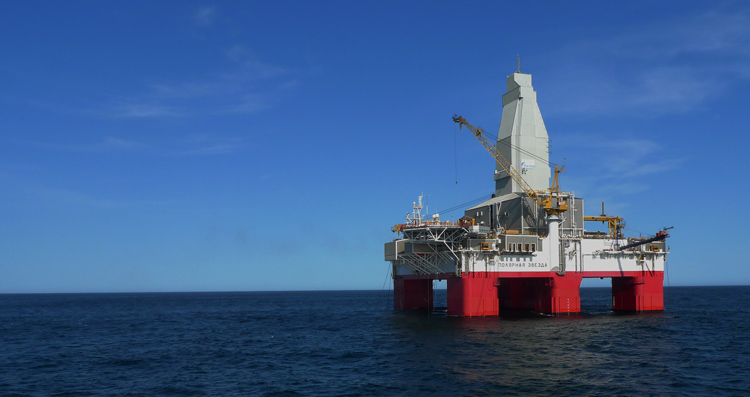
Russia is the most rich country in terms of gas reserves, and the first in terms of the amount of export and production of natural gas. The main deposits were discovered in the Arctic, North-West Siberia and the Far East. Some gas fields in the Russian Federation are not only the largest in the world, but also unique. Below we present the largest gas fields in the Russian Federation.
Urengoyskoye gas field
The Urengoyskoye field belongs to the category of supergiant. In terms of the amount of gas reserves, it firmly ranks third on the planet. Sixteen trillion cubic meters is roughly how the volume of gas that it is capable of producing is estimated. The deposit was first discovered in the Yamalo-Nenets Autonomous Okrug in 1966, near the village of Urengoy. Already in the seventy-eighth, capital production began, and since 1984, gas from Urengoy began to be supplied to Western countries. To date, slightly less than 70 percent of all underground reserves have been developed. But developments are not losing their intensity. So, last year, new powerful pumping stations were built and put into operation, which allow increasing the production and transportation of gas from this region. Since 2009, the development of the Achimov layers of the Urengoyskoye field has been underway, which makes it possible to obtain more than 90 percent of gas condensate.
Yamburgskoye gas field
Yamburgskoye has reserves of about 8.2 trillion cubic meters of gas and belongs to the world's largest fields. The opening falls on 1969 on the Tazovsky Peninsula in the Yamalo-Nenets Autonomous District. In the eightieth year, the gas from this field began to be produced on an industrial scale. According to the latest data, about forty-six percent of the total gas volume has been developed. The peculiarities of the Yambur field include gas production in permafrost conditions, the thickness of the frozen ground reaches 40-50 meters. Drilling is carried out to a depth of 1 to 3 km.
Bovanenkovskoye gas field
The Bovanenkovskoye field is also not inferior to many world reserves in terms of gas reserves. 4.9 trillion cubic meters - this figure, according to experts, characterizes its volume. 1971 saw the discovery of these gas reserves on the Yamal Peninsula. For one reason or another, gas production from this field has been constantly postponed since 2001. After the start of continuous production in 2012, it began to actively supply gas for export. The main recipient of raw materials is China. In 2014, the second gas field was commissioned. This makes it possible to increase production to 90 billion cubic meters of gas per year. The Bovanenkovskoye field can be safely called promising.
Shtokman gas field
The Shtokman field is rightfully one of the richest in terms of gas and gas condensate reserves. The volumes of gas and condensate located there are estimated at 3.94 trillion cubic meters and 56 million tons, respectively. It was first discovered in 1981. The first trial production was carried out in 1988. Located in the Barents Sea, between Murmansk and Novaya Zemlya. Sea depths from 300 to 400 meters. The dates for launching the field at full capacity are constantly being postponed. Latest figures point to 2019.
Leningradskoe
The Leningradskoye gas condensate field, like many others, was discovered in the ninety-second year of the last century. According to the estimated reserves, it immediately received the title - gigantic. According to the latest data, the amount of gas stored there may be about 3 trillion cubic meters. Condensate deposits are estimated at about 3 million tons. The location falls on the southwestern part of the Kara Sea.
Rusanovskoye gas field
The Rusanovskoye gas field is one of the unique ones. The opening falls on 1992. Located on the continental shelf of the Northwest Platform. Kara Sea. The reserves are estimated at 779 billion tons of gas, however, there is an assumption that this figure could reach three trillion cubic meters and 7.8 million tons of gas condensate. The main developed reserves are located at depths from one and a half to two and a half kilometers.
Zapolyarnoye gas field
The Zapolyarnoye gas condensate field was discovered in 1965 between Urengoy and the village of Tazovsky. In terms of gas reserves, it belongs not only to the largest deposits in Russia, but also ranks fifth in the world. Initial reserves were determined at 2.6 trillion cubic meters. Commissioning took place in 2001.
Bear gas field
Bear gas field is not only one of the largest, but also unique. Opened in 1967. It has been in constant operation since 1972. Located in the Yamalo-Nenets District. Initial gas reserves were estimated at 4.7 trillion cubic meters. To date, almost half of it has been worked out. In terms of the amount of gas produced, this field accounts for about four percent of all gas production in Russia. Despite the significant production due to natural features, it can get a "second wind" by 2030. This is evidenced by the work on the modernization of equipment and improvement of gas production, which will be completed in 2017.
Astrakhan gas field
The Astrakhan gas field dates back to 1976. It was discovered near Astrakhan and became part of the Caspian region of oil and gas development. Estimated reserves: 2.5 trillion cubic meters of gas and 400 million tons of condensate. Full-scale operation began in 1987. In 2014, another large gas field was found near Astrakhan. The discovery, made for the first time in 20 years, suggests that the area is still rich in surprises.
Sakhalin-3 gas production project
Sakhalin-3 is a promising project for the development and development of several large gas fields discovered and discovered since the late seventies of the last century in the Pacific Ocean, east of Sakhalin Island. The main ones are the Kirinskoye, Yuzhno-Kirinskoye and Mynginskoye gas fields. It is planned to produce gas at the level of 1.1 billion cubic meters of gas.
The table shows a list with brief characteristics the most important gas fields in the Russian Federation.
| Field name | Field type | opening date | General stocks(projected) | Location |
| Zapolyarnoye | oil and gas condensate | 1965 year | 735 billion m3 of gas | in the Tazovsky District of the Yamalo-Nenets Autonomous Okrug (Yamalo-Nenets Autonomous Okrug), 80 km east of the Urengoyskoye field and 85 km south of the village of Tazovsky |
| Sakhalin-3 (4 blocks of fields are included: Kirinsky, Veninsky, Ayashsky and Vostochno-Odoptinsky) |
oil and gas | 1992 (Kirinsky) | 1.4 trillion m3 of natural gas 700 million tons of oil | On the coast of Sakhalin Island, on the shelf of the Sea of Okhotsk. |
| Rusanovskoe | condensate gas | 1992 year | 3.0 trillion m3 natural gas |
located in the Kara Sea. |
| Leningradskoe | dry methane gas (91 to 99%) | 1992 year | 3.0 trillion m3 natural gas |
located in the Kara Sea. |
| Shtokman (Shtokman) | gas condensate | 1988 year | 3.7 trillion m3 of gas 31 million tons of condensate |
Located in the central part of the shelf Russian sector Barents Sea 600 km northeast of Murmansk. Depths |
Bovanenkovskoe (total with Kharasaveyskoe Novoportovsky) |
oil and gas condensate | 1971 year | 5.9 trillion cubic meters m of gas 100.2 million tons of condensate 227 million tons of oil (of their 4.9 trillion cubic meters of natural gas - at Bovanenkovskoe |
Bovanenkovo is located on the Yamal Peninsula, 40 kilometers from the coast of the Kara Sea, the lower reaches of the Syo-Yakha, Morda-Yakha and Inflate-Yaha. ... |
| Yamburgskoe (YOGKM) | oil and gas condensate | 1969 year | field of gas, gas condensate and oil. |
Located in the Polar part of the West Siberian Plain, on the Taz Peninsula in the subarctic zone. |
| Urengoyskoe | gas | 1966 year | 10 trillion m3. (10¹³ m³). natural gas |
It is located in the Yamalo-Nenets Autonomous District of the Tyumen Region of Russia, slightly south of the Arctic Circle. Novy Urengoy. |
World gas reserves
Proved reserves are the portion of reserves that are likely to be recovered from developed fields under current economic and technical conditions.
Probable reserves are a part of reserves, information about which is insufficient to say unambiguously whether they can be developed in the existing economic and technical conditions. But probable reserves can be cost-effective even with a small increase in information about them and the development of production technology.
Potential reserves are those reserves, information about which is sufficient only to give an approximate estimate of the cost of extraction or indicate the optimal recovery method, but only with a low degree of probability.
In other words, probable and probable reserves differ from those proven in that either it is impractical to develop them at the current level of prices and applied technologies, or information about them is insufficient.
However, proven hydrocarbon reserves are shrinking and gas prices are rising. New, more advanced gas production technologies are emerging. Therefore, in the end, probable and possible gas reserves can become proven.
World reserves of natural gas
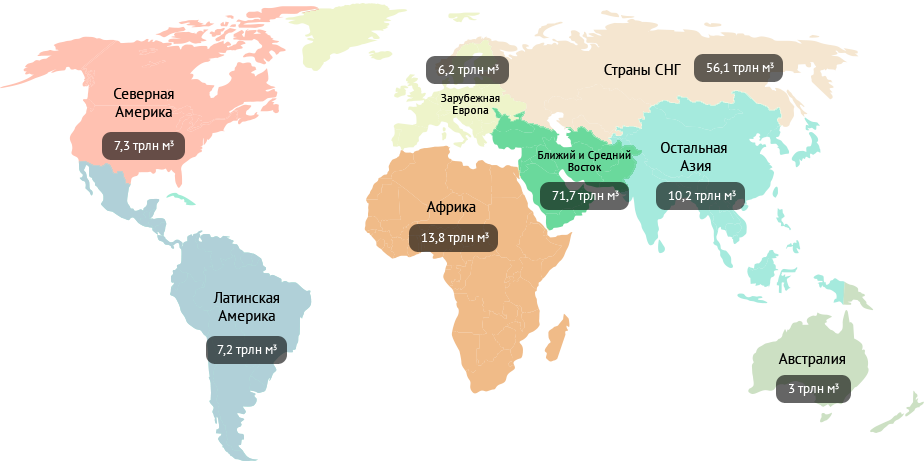
However, natural gas is not only found underground in purely gas fields. Significant amounts of it are concentrated in coal seams, in groundwater and in the form gas hydrates.
Accidents with tragic consequences in coal mines are usually associated with the methane contained in coal. Methane is sorbed in the rock mass. Geologists believe that methane reserves in all coal-bearing regions of the world are close to 500 trillion cubic meters.
Methane is also found in groundwater. The amount of dissolved gases in them exceeds all explored gas reserves in the traditional form. For example, 736 trillion cubic meters of methane are dissolved in the formation waters of the Gulf Coast field (USA), while natural gas reserves in purely gas fields in the United States amount to only 4.7 trillion cubic meters.
Another major source of methane can be gas hydrates - its compounds with water resemble March snow in appearance. One cubic meter of gas hydrate contains about 200 m³ of gas. Deposits of gas hydrates are found in sediments of deep water areas and in the bowels of land with powerful permafrost (for example, in the polar part of the Tyumen region, off the coast of Alaska, the coasts of Mexico and North America).
Scientists believe that 90% of the world's oceans store gas hydrates. If this assumption is confirmed, then gas hydrates can become an inexhaustible source of hydrocarbons.Deposits-giants
Natural gas fields are classified into the following groups by the amount of reserves:
- Small- up to 10 billion m³;
- Average- from 10 to 100 billion m³;
- Large- from 100 to 1 trillion m³;
- Largest (giant)- 1-5 trillion m³;
- Unique ("super giant")- over 5 trillion m³.
| Field | Opening year | Reserves (trillion m³) | Oil and gas basin | |
|---|---|---|---|---|
| 1. Qatar / Iran | South Pars / North | 1991 | 28 | Persian Gulf |
| 2. Turkmenistan | Galkanysh (South Yolotan) |
2006 | 21.4 | Murghab |
| 3. Russia | Urengoyskoe | 1966 | 10.2 | Western Siberia |
| 4. USA | Haynesville | 2008 | 7 | Mid Continent |
| 5. Russia | Yamburgskoe | 1969 | 5.2 | Western Siberia |
| 6.Russia | Bovanenkovskoe | 1971 | 4.9 | Yamal and the Kara Sea |
Of the 10 largest gas fields in the world, the initial reserves of which in 2012 amounted to at least 80 trillion m³, half are located in Russia.
However, the largest, South Pars / North is located in the territorial waters of Qatar and Iran. The reserves of this field are estimated at 28 trillion m³ of gas and 7 billion tons of oil. In third place in the world is the Urengoyskoye oil and gas condensate field with total geological reserves of 16 trillion cubic meters and residual reserves of 10.2 trillion cubic meters. The youngest field of the top ten, Haynesville, was discovered in the USA in 2008.
Note that the three largest fields in the world are concentrated on the territory of the oil and gas basin of Western Siberia - Urengoyskoye, Yamburgskoye and Zapolyarnoye.
Shares in world proven gas reserves





